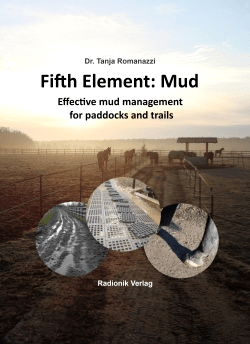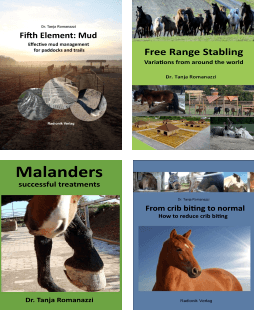Fifth Element: Mud

Dear stable owners,
Mud – it’s one of the largest problems facing free range stablers. You want to provide your horses with plenty of natural outdoor exercise. But as space for this is generally limited, overuse can quickly turn your paddock into a muddy wasteland.
As neither the horses nor their owners enjoy having to squelch their way across the entire area, you will have to install footings in some places. Books on mud management generally describe how to install an elaborate three-course-footing, which tends to be too costly for most people. The internet offers a wealth of creative suggestions, but it can be difficult to tell in advance how feasible some of them are.
Which is why this book offers a fundamental overview of different methods of mud management, as well as construction materials and dividing courses that can be used.
It explains how to assess your own soil in order to be able choose the most suitable footing. Experts on hoof care have also contributed a detailed look at consequences for hoof health and the book also presents ten examples of successful mud management strategies, including a breakdown of the respective costs.
Table of Contents
Mud – a widespread problem
Footing: why, where and how?
Legal requirements
What is soil sealing?
When do I need a permit?
The basics: soil
What kind of soil do you have?
Basic mud management strategies
Base course, dividing course, surface course
On-top construction
No base course
No dividing course
No surface course
Only one course
Without anything
Drainage
Incline
Infiltration
Drainage systems
Construction materials and their suitability
Crushed stone
Gravel
Grit
Lava
Slag
Asphalt concrete
Sand
Wood chips
Miscanthus
Bark mulch
Carpet shreds
Dividing course
Plastic grids
Textiles
Rubber
Concrete components
Artificial turf
Paper screens
Stone meal and crushed sand
Wood chips and cement
Footings for special requirements
Conservation areas
Steep inclines
Water fords
Footing and hoof health – consulting the experts
Jörg Weber, barefoot hoofcare specialist
Chris Gehrmann, Eifel hoof clinic
Kati Haas, barefoot hoofcare specialist
Barbara & Patrick Spieleder, Institute for hoof health, Austria
Christina Kuenen & Barbara Kelly, Team HUF
Our own experiences
Ten examples of successful footings
140 m²: Reclaimed crushed stone and pig slats
300 m²: Wet-mix aggregate with no dividing course
800 m²: Sand and no dividing course
166 m²: Grass pavers with a base course and surface course
360 m²: Various footings
2.000 m²: One course with construction rubble
110 m²: Plastic grid directly on top of the mud
200 m²: Grids with a base course and a surface course
6.500 m²: Plastic grids with no base course
150 m²: non-woven geotextiles on the topsoil
A few thoughts in conclusion
References
Ebook: Fifth element: Mud. Effective mud management for paddocks and trails.
Author: Dr. Tanja Romanazzi. Ebook as pdf-file with 171 pages A5 format, published March 2014, translated from German to English in January 2016, price: €20.47 + VAT


